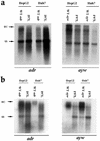Replication advantage and host factor-independent phenotypes attributable to a common naturally occurring capsid mutation (I97L) in human hepatitis B virus
- PMID: 12414948
- PMCID: PMC136898
- DOI: 10.1128/jvi.76.23.12069-12077.2002
Replication advantage and host factor-independent phenotypes attributable to a common naturally occurring capsid mutation (I97L) in human hepatitis B virus
Abstract
Mutations of human hepatitis B virus (HBV) occur frequently within the capsid (core) protein in natural infections. The most frequent mutation of the core protein in HBV from Southeast Asia occurs at amino acid 97, changing an isoleucine (I) to a leucine (L). In our systematic study of virus-host interactions, we have examined the replication efficiency of a site-directed mutant, I97L, and its parental wild-type HBV in several different hepatoma cell lines. Interestingly, we found that this capsid variant replicated in human Huh7 hepatoma cells approximately 4.8-fold better than its parental wild-type HBV. A similar phenomenon was observed in another hepatoma cell line, J3. In addition, the level of encapsidated RNA pregenome in mutant I97L was about 5.7-fold higher than that of the wild-type HBV in Huh7 cells. Unlike Huh7 cells, no significant difference in viral DNA replication between the same I97L mutant and its parental wild-type HBV was observed in HepG2, a human hepatoblastoma cell line. This finding of a profound replication advantage for mutant I97L in Huh7 and J3 cells but not in HepG2 cells may have important implications for the emergence of this mutant in chronic HBV carriers. We speculate here that the mutation confers a host factor-independent growth advantage for the survival of HBV variants in gradually dedifferentiating hepatocytes and thus helps prolong viral persistence.
Figures





Similar articles
-
Persistence of Hepatitis B Virus DNA and the Tempos between Virion Secretion and Genome Maturation in a Mouse Model.J Virol. 2019 Oct 29;93(22):e01001-19. doi: 10.1128/JVI.01001-19. Print 2019 Nov 15. J Virol. 2019. PMID: 31462567 Free PMC article.
-
Subtype-independent immature secretion and subtype-dependent replication deficiency of a highly frequent, naturally occurring mutation of human hepatitis B virus core antigen.J Virol. 1999 Dec;73(12):10122-8. doi: 10.1128/JVI.73.12.10122-10128.1999. J Virol. 1999. PMID: 10559327 Free PMC article.
-
Amino Acid Polymorphism in Hepatitis B Virus Associated With Functional Cure.Cell Mol Gastroenterol Hepatol. 2021;12(5):1583-1598. doi: 10.1016/j.jcmgh.2021.07.013. Epub 2021 Aug 2. Cell Mol Gastroenterol Hepatol. 2021. PMID: 34352407 Free PMC article.
-
Virion Secretion of Hepatitis B Virus Naturally Occurring Core Antigen Variants.Cells. 2020 Dec 30;10(1):43. doi: 10.3390/cells10010043. Cells. 2020. PMID: 33396864 Free PMC article. Review.
-
Hepatitis B virus pre-S/S variants in liver diseases.World J Gastroenterol. 2018 Apr 14;24(14):1507-1520. doi: 10.3748/wjg.v24.i14.1507. World J Gastroenterol. 2018. PMID: 29662289 Free PMC article. Review.
Cited by
-
Stability and morphology comparisons of self-assembled virus-like particles from wild-type and mutant human hepatitis B virus capsid proteins.J Virol. 2003 Dec;77(24):12950-60. doi: 10.1128/jvi.77.24.12950-12960.2003. J Virol. 2003. PMID: 14645551 Free PMC article.
-
Hepatitis B virus core protein with hot-spot mutations inhibit MxA gene transcription but has no effect on inhibition of virus replication by interferon α.Virol J. 2010 Oct 20;7:278. doi: 10.1186/1743-422X-7-278. Virol J. 2010. PMID: 20959021 Free PMC article.
-
HBV maintains electrostatic homeostasis by modulating negative charges from phosphoserine and encapsidated nucleic acids.Sci Rep. 2016 Dec 13;6:38959. doi: 10.1038/srep38959. Sci Rep. 2016. PMID: 27958343 Free PMC article.
-
Nucleolar localization of human hepatitis B virus capsid protein.J Virol. 2004 Dec;78(24):13653-68. doi: 10.1128/JVI.78.24.13653-13668.2004. J Virol. 2004. PMID: 15564475 Free PMC article.
-
Reduced secretion of virions and hepatitis B virus (HBV) surface antigen of a naturally occurring HBV variant correlates with the accumulation of the small S envelope protein in the endoplasmic reticulum and Golgi apparatus.J Virol. 2005 Nov;79(21):13483-96. doi: 10.1128/JVI.79.21.13483-13496.2005. J Virol. 2005. PMID: 16227269 Free PMC article.
References
-
- Akarca, U. S., and A. S. F. Lok. 1995. Naturally occurring hepatitis B virus core gene mutations. Hepatology 22:50-60. - PubMed
-
- Alexander, J. J., E. M. Bey, E. W. Geddes, and G. Lecatsas. 1976. Establishment of a continuously growing cell line from primary carcinoma of the liver. S. Afr. J. Med. 50:2124-2128. - PubMed
-
- Beames, B., and R. E. Lanford. 1993. Carboxy-terminal truncations of the HBV core protein affect capsid formation and the apparent size of the encapsidated HBV RNA. Virology 194:597-607. - PubMed
-
- Bozkaya, H., B. Ayola, and A. S. F. Lok. 1996. High rate of mutations in the hepatitis B core gene during the immune clearance phase of chronic hepatitis B virus infection. Hepatology 24:32-37. - PubMed
Publication types
MeSH terms
Substances
Grants and funding
LinkOut - more resources
Full Text Sources

